康复机器人教程文件
- 格式:ppt
- 大小:6.81 MB
- 文档页数:31

0 生产许可证:粤食药监械生产许号产品标准号:YZB/粤0824-2010肢体智能反馈训练系统A2 (商品名称:上肢康复机器人)说明书广州一康医疗设备实业有限公司广州一康医疗设备实业有限公司版权所有,保留所有权利。
本文中的信息将取代所有以前出版资料中的信息。
该文档版本:目录1. 适用范围 (1)2. 治疗指导 (1)3. 安全须知 (2)4. 符号说明 (2)5. 简介 (3)6. 功能特点 (3)7. 规格标准 (4)配置清单表 (6)8. 设备操作说明 (6)9. 软件操作说明 (9)系统主界面 (9)选择患者 (10)训练设置 (11)进入训练 (12)训练信息 (13)评估系统 (14)评估报告 (15)10. 清洁及维护 (17)11. 保修条款 (17)1. 适用范围适应上肢偏瘫及功能障碍的患者针对脑血管疾病、严重脑外损伤或其它的神经系统疾病造成上肢功能障碍及手术后恢复上肢功能的患者,如脑卒中、帕金森、脑血栓等。
级以上肌力等级的偏瘫患者。
由于是主动训练系统,所以要求患者的上肢至少要有微弱运动能力。
肢体智能反馈训练系统A2是用于治疗的训练仪器,而非以诊断为目的的医疗设备。
2. 治疗指导根据患者的不同,治疗的目的可以是保持活动(预防治疗),或者手术、受伤后的康复。
我们建议肢体智能反馈训练系统作为医生或治疗师开出的训练方案的一个部分。
为了提高训练的积极性和追求更好的训练效果,我们建议利用强化的反馈训练进行具体任务的功能训练治疗。
3. 安全须知●肢体智能反馈训练系统只可以连接在与标牌上的规格相符的电源上。
将设备连接在合适的电源插座中。
(电源插座必须要有接大地)●主机的信号输出部分与计算机连接时,必须用配套的USB线相连。
●电源线的放置应该不影响行人,不会触及可移动的结构,并且不会被其他设备所损坏。
不得使用损坏的电源线,只可以使用设备原装的电源线。
●为了防止触电,肢体智能反馈训练系统不可以在潮湿或高温等恶劣环境中使用:仪器工作温度应在5℃~40℃,环境相对湿度应小于80%。

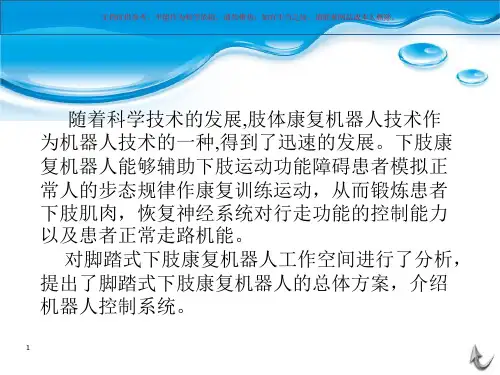
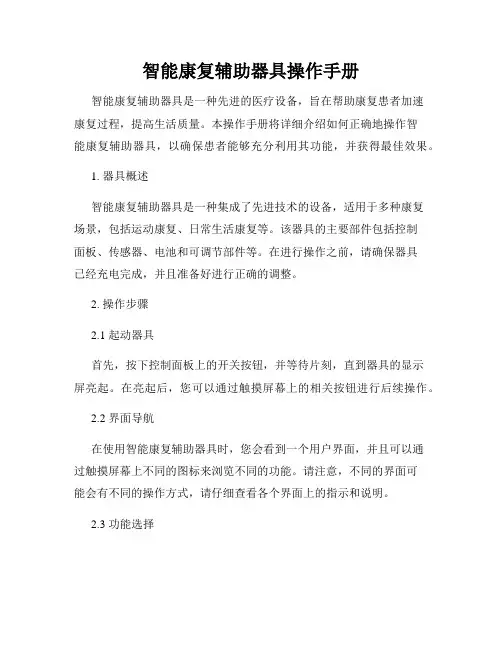
智能康复辅助器具操作手册智能康复辅助器具是一种先进的医疗设备,旨在帮助康复患者加速康复过程,提高生活质量。
本操作手册将详细介绍如何正确地操作智能康复辅助器具,以确保患者能够充分利用其功能,并获得最佳效果。
1. 器具概述智能康复辅助器具是一种集成了先进技术的设备,适用于多种康复场景,包括运动康复、日常生活康复等。
该器具的主要部件包括控制面板、传感器、电池和可调节部件等。
在进行操作之前,请确保器具已经充电完成,并且准备好进行正确的调整。
2. 操作步骤2.1 起动器具首先,按下控制面板上的开关按钮,并等待片刻,直到器具的显示屏亮起。
在亮起后,您可以通过触摸屏幕上的相关按钮进行后续操作。
2.2 界面导航在使用智能康复辅助器具时,您会看到一个用户界面,并且可以通过触摸屏幕上不同的图标来浏览不同的功能。
请注意,不同的界面可能会有不同的操作方式,请仔细查看各个界面上的指示和说明。
2.3 功能选择通过触摸屏幕上的功能图标,您可以选择不同的功能来满足康复需求。
例如,如果您需要进行运动康复,可以选择相应的训练模式,然后按照屏幕上的指示进行操作。
2.4 调节参数智能康复辅助器具通常提供了一些可以调节的参数,以满足不同患者的需求。
您可以通过触摸屏幕上的设置图标,进入调节参数的界面,并根据需要进行相应的调整。
请注意,对参数的任何修改都应在医生或专业人士的指导下进行。
2.5 实时监测智能康复辅助器具通常会配备传感器,用于实时监测患者的运动状态,以及提供相应的反馈。
在进行康复训练时,请注意观察显示屏上的实时数据,并根据需要进行相应的调整。
2.6 结束操作当您完成康复训练或使用智能康复辅助器具之后,请按下控制面板上的关机按钮,并等待器具完全关闭。
请记得将器具妥善存放,以确保其安全性和正常运行。
3. 注意事项在操作智能康复辅助器具时,请务必注意以下事项:- 请严格按照医生或专业人士的指导进行操作,不要擅自调整参数或使用错误的功能;- 在训练或使用过程中,如遇到任何不适或异常情况,请立即停止操作,并联系医生或专业人士进行咨询;- 请保持器具的清洁和卫生,按照说明书的要求进行清洁和消毒;- 请定期检查器具的电池电量,并确保充电及时。
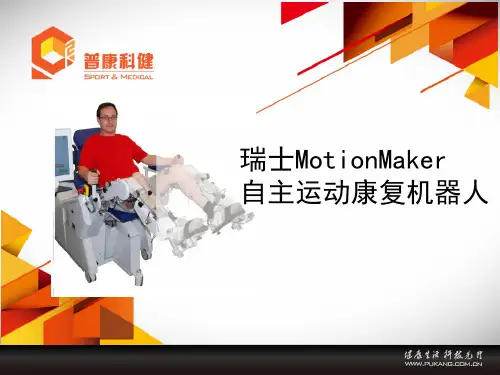
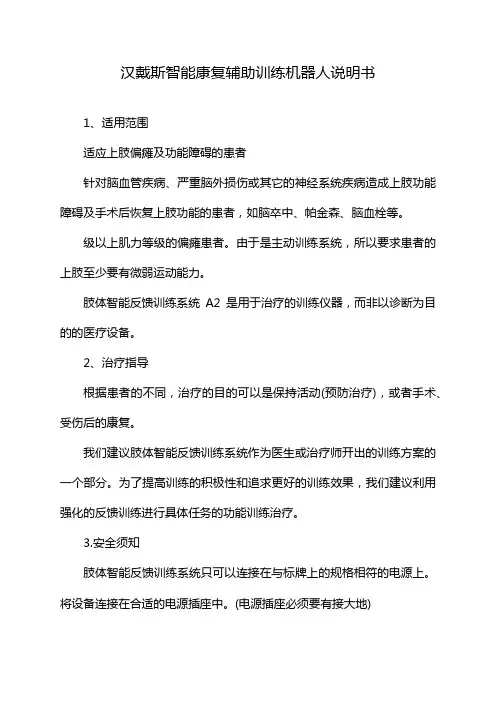
汉戴斯智能康复辅助训练机器人说明书1、适用范围适应上肢偏瘫及功能障碍的患者针对脑血管疾病、严重脑外损伤或其它的神经系统疾病造成上肢功能障碍及手术后恢复上肢功能的患者,如脑卒中、帕金森、脑血栓等。
级以上肌力等级的偏瘫患者。
由于是主动训练系统,所以要求患者的上肢至少要有微弱运动能力。
肢体智能反馈训练系统A2是用于治疗的训练仪器,而非以诊断为目的的医疗设备。
2、治疗指导根据患者的不同,治疗的目的可以是保持活动(预防治疗),或者手术、受伤后的康复。
我们建议肢体智能反馈训练系统作为医生或治疗师开出的训练方案的一个部分。
为了提高训练的积极性和追求更好的训练效果,我们建议利用强化的反馈训练进行具体任务的功能训练治疗。
3.安全须知肢体智能反馈训练系统只可以连接在与标牌上的规格相符的电源上。
将设备连接在合适的电源插座中。
(电源插座必须要有接大地)主机的信号输出部分与计算机连接时,必须用配套的USB线相连。
电源线的放置应该不影响行人,不会触及可移动的结构,并且不会被其他设备所损坏。
不得使用损坏的电源线,只可以使用设备原装的电源线。
为了防止触电,肢体智能反馈训练系统不可以在潮湿或高温等恶劣环境中使用:仪器工作温度应在5℃~40℃,环境相对湿度应小于80%。
在首次使用时,应由医生或供应商展示如何操作此设备。
在设备运转过程中,不要靠近或试图卸下活动着的部分。
若患者在训练过程中或训练之后出现任何异常症状,要立即与医生联络。
只有当电源线插头从电源插座中完全拔出来以后,训练器才完全断电。
在打开外设备外壳之前,一定要将插头从插座中拔出。
外壳打开时设备不可使用。
维修只可以由授权的专业人士进行。
若设备有任何损坏、任何噪声或气味异常,立即停止训练,把电源切断,联系服务工程师。
清洁设备时不可以使用有腐蚀性的液体。
系统部件中未规定的组件不得接入系统。
操作者和患者的不允许触电脑USB线的输出接口。

上肢康复说明书上肢康复说明书1.产品概述1.1 产品名称1.2 产品型号1.3 产品特点1.4 适用对象1.5 主要用途1.6 技术规格2.产品组成2.1 主体2.2 控制系统2.3 传感器2.4 动力系统2.5 操作界面2.6 附件3.使用方法3.1 安装与组装3.2 启动与关闭3.3 操作界面介绍3.4 使用姿势及调整4.功能操作4.1 动作模式选择 4.2 运动范围调节 4.3 力度调节4.4 速度调节4.5 记录与回放功能5.维护与保养5.1 日常清洁5.2 维护与保养周期 5.3 故障排除方法5.4 零部件更换6.安全注意事项6.1 使用环境要求6.2 使用人员要求6.3 电气安全6.4 机械安全6.5 输配电系统安全6.6 紧急情况处理7.相关法律名词及注释7.1 法律名词解释7.2 相关法律法规引用附件:附件1、上肢康复使用手册附件2、上肢康复维修记录表本文所涉及的法律名词及注释:1.:根据《与智能化制造》法律法规,指能执行工作任务并与人类进行交互的多功能下肢康复装置。
2.控制系统:指中用于控制动作与功能的电子系统,用于指挥的运动和执行特定任务。
3.传感器:指中的感知模块,用于感知外部环境或人体动作,并将其转化为相应的信号用于控制系统分析和处理。
4.动力系统:指为提供动力的部分,通常包括电机、减速器和传动装置等组成部分。
5.操作界面:上的界面设备,例如触摸屏、按钮等用于用户与进行交互,设定和调整参数。
6.附件:指附属的额外组件,例如使用手册、配件、维修记录表等。

0 生产许可证:粤食药监械生产许20030845号产品标准号:YZB/粤0824-2010肢体智能反馈训练系统A2 (商品名称:上肢康复机器人)说明书广州一康医疗设备实业有限公司广州一康医疗设备实业有限公司版权所有,保留所有权利。
本文中的信息将取代所有以前出版资料中的信息。
该文档版本:V1.09目录1. 适用范围 (1)2. 治疗指导 (1)3. 安全须知 (1)4. 符号说明 (2)5. 简介 (2)6. 功能特点 (3)7. 规格标准 (4)8. 设备操作说明 (6)9. 软件操作说明 (8)9.1 系统主界面 (8)9.2 选择患者 (9)9.3 训练设置 (11)9.4 进入训练 (12)9.5 训练信息 (13)9.6 评估系统 (14)9.7 评估报告 (14)10. 清洁及维护 (16)11. 保修条款 (16)1. 适用范围适应上肢偏瘫及功能障碍的患者针对脑血管疾病、严重脑外损伤或其它的神经系统疾病造成上肢功能障碍及手术后恢复上肢功能的患者,如脑卒中、帕金森、脑血栓等。
级以上肌力等级的偏瘫患者。
由于是主动训练系统,所以要求患者的上肢至少要有微弱运动能力。
肢体智能反馈训练系统A2是用于治疗的训练仪器,而非以诊断为目的的医疗设备。
2. 治疗指导根据患者的不同,治疗的目的可以是保持活动(预防治疗),或者手术、受伤后的康复。
我们建议肢体智能反馈训练系统作为医生或治疗师开出的训练方案的一个部分。
为了提高训练的积极性和追求更好的训练效果,我们建议利用强化的反馈训练进行具体任务的功能训练治疗。
3. 安全须知●肢体智能反馈训练系统只可以连接在与标牌上的规格相符的电源上。
将设备连接在合适的电源插座中。
(电源插座必须要有接大地)●主机的信号输出部分与计算机连接时,必须用配套的USB线相连。
●电源线的放置应该不影响行人,不会触及可移动的结构,并且不会被其他设备所损坏。
不得使用损坏的电源线,只可以使用设备原装的电源线。
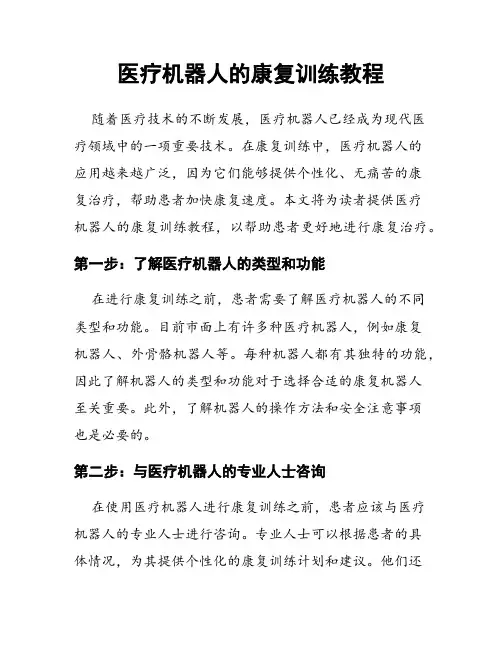
医疗机器人的康复训练教程随着医疗技术的不断发展,医疗机器人已经成为现代医疗领域中的一项重要技术。
在康复训练中,医疗机器人的应用越来越广泛,因为它们能够提供个性化、无痛苦的康复治疗,帮助患者加快康复速度。
本文将为读者提供医疗机器人的康复训练教程,以帮助患者更好地进行康复治疗。
第一步:了解医疗机器人的类型和功能在进行康复训练之前,患者需要了解医疗机器人的不同类型和功能。
目前市面上有许多种医疗机器人,例如康复机器人、外骨骼机器人等。
每种机器人都有其独特的功能,因此了解机器人的类型和功能对于选择合适的康复机器人至关重要。
此外,了解机器人的操作方法和安全注意事项也是必要的。
第二步:与医疗机器人的专业人士咨询在使用医疗机器人进行康复训练之前,患者应该与医疗机器人的专业人士进行咨询。
专业人士可以根据患者的具体情况,为其提供个性化的康复训练计划和建议。
他们还可以教授患者正确的操作方法,确保康复训练的安全性和有效性。
第三步:制定康复训练计划根据医疗机器人的类型和功能,患者可以与专业人士一起制定康复训练计划。
康复训练计划应该根据患者的康复需求和目标进行个性化设计,以确保康复治疗的效果。
计划中应包括康复训练的时间、强度和频率等方面的安排。
患者可以根据自己的实际情况逐步调整康复训练计划。
第四步:正确操作医疗机器人在进行康复训练时,患者必须正确地操作医疗机器人。
在使用医疗机器人之前,患者应该仔细阅读相关的操作说明和安全提示,并严格遵守这些指导。
在操作过程中,患者应该尽量与机器人保持良好的沟通,遵循机器人的指导进行动作。
如果遇到任何疑问或困难,患者应该及时寻求专业人士的帮助。
第五步:保持积极的心态和锻炼习惯在进行医疗机器人的康复训练期间,患者需要保持积极的心态和良好的锻炼习惯。
康复训练是一个漫长而艰难的过程,患者可能会面临挫折和困难。
然而,只要保持积极的心态并坚持锻炼,康复的效果将会更加显著。
第六步:定期评估康复进展在康复训练进行的过程中,定期评估康复进展是必要的。
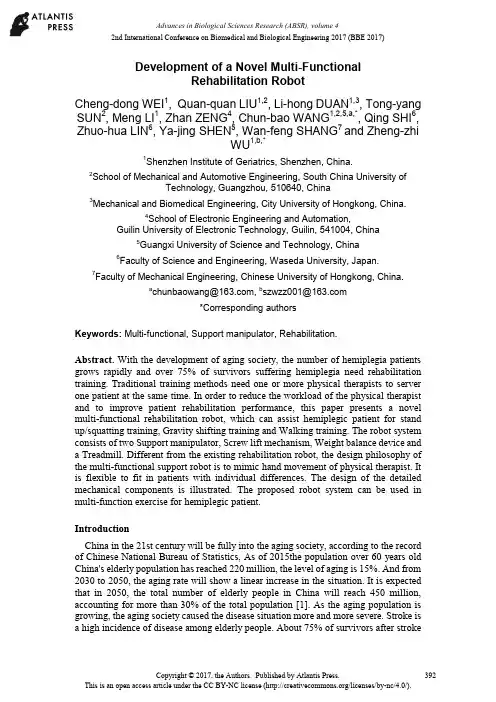
Development of a Novel Multi-FunctionalRehabilitation RobotCheng-dong WEI1, Quan-quan LIU1,2, Li-hong DUAN1,3, Tong-yangSUN2, Meng LI1, Zhan ZENG4, Chun-bao WANG1,2,5,a,*, Qing SHI6,Zhuo-hua LIN6, Ya-jing SHEN5, Wan-feng SHANG7 and Zheng-zhiWU1,b,*1Shenzhen Institute of Geriatrics, Shenzhen, China.2School of Mechanical and Automotive Engineering, South China University ofTechnology, Guangzhou, 510640, China3Mechanical and Biomedical Engineering, City University of Hongkong, China.4School of Electronic Engineering and Automation,Guilin University of Electronic Technology, Guilin, 541004, China5Guangxi University of Science and Technology, China6Faculty of Science and Engineering, Waseda University, Japan.7Faculty of Mechanical Engineering, Chinese University of Hongkong, China.a*******************,b*****************Corresponding authorsKeywords: Multi-functional, Support manipulator, Rehabilitation.Abstract. With the development of aging society, the number of hemiplegia patientsgrows rapidly and over 75% of survivors suffering hemiplegia need rehabilitationtraining. Traditional training methods need one or more physical therapists to serverone patient at the same time. In order to reduce the workload of the physical therapistand to improve patient rehabilitation performance, this paper presents a novelmulti-functional rehabilitation robot, which can assist hemiplegic patient for standup/squatting training, Gravity shifting training and Walking training. The robot systemconsists of two Support manipulator, Screw lift mechanism, Weight balance device anda Treadmill. Different from the existing rehabilitation robot, the design philosophy ofthe multi-functional support robot is to mimic hand movement of physical therapist. Itis flexible to fit in patients with individual differences. The design of the detailedmechanical components is illustrated. The proposed robot system can be used inmulti-function exercise for hemiplegic patient.IntroductionChina in the 21st century will be fully into the aging society, according to the recordof Chinese National Bureau of Statistics, As of 2015the population over 60 years oldChina's elderly population has reached 220 million, the level of aging is 15%. And from2030 to 2050, the aging rate will show a linear increase in the situation. It is expectedthat in 2050, the total number of elderly people in China will reach 450 million,accounting for more than 30% of the total population [1]. As the aging population isgrowing, the aging society caused the disease situation more and more severe. Stroke isa high incidence of disease among elderly people. About 75% of survivors after strokehave disability, more than 40% for severely disabled. So the elderly service and rehabilitation industry in the world will pay attention [2].For stroke sequelae, traditional rehabilitation training includes Gravity shifting training (Fig.1.a), stand up/squatting training (Fig.1.b) and Walking training(Fig.1.c) [3]. The main means of rehabilitation is based on the therapis to treat the patient as one to one, even several-to-one. Which makes the number of therapists seriously inadequate, and the rehabilitation effect is too dependent on the therapists' own technology and experience, heavy training process makes the therapists' work burden is too large. These factors have a serious impact on the patient's rehabilitation effect .(a) (b) (c)Figure 1. Traditional rehabilitation trainingThe existing lower limb rehabilitation robot from the functional and structural can be divided into single weight-free robot, pedal robot, bed robot, exoskeleton robot and so on. Single weight-free robot, such as Kine Assist [4] of the University of Chicago, which is shown in Fig.2.(a). Pedal robot, such as German Gait Trainer [5], which is shown in Fig.2.(b). Bed robot, such as Swiss Erigo [6], which is shown in Fig.2.(c). Exoskeleton robot, such as Japanese HAL[7], which is shown in Fig.2.(d). So we propose a multi-functional intelligent rehabilitation robot based on bionics design is proposed to simulate the rehabilitation of the therapists, to guide the patients to participate in the training and improve the rehabilitation training effect.(a) Kine Assist (b) Gait Trainer (c) Erigo (d) HALFigure2. Research on lower limb robo tThe existing rehabilitation robots pay more attention to the rehabilitation of patients with passive training to patient gait tend to healthy human training purpose .In this research, a novel multifunctional rehabilitation robot is proposed, its design philosophy is based on the therapist in the patient rehabilitation training process of the simulation, to guide the patients to participate in the training and improve the rehabilitation training effect. The rest of this paper is organized as follows: Section II gives an introduction of analysis requirements which are composed of the physiological requirement and the rehabilitation requirement. Section III describes the mechanism design in details. Section IV presents the conclusion and future research direction of Multi - functional rehabilitation robot.Requirement AnalysisPhysiological RequirementsThe lower limb joints of the human body are mainly composed of hip knee and ankle. Traditional rehabilitation methods mainly for hemiplegic patients with lower limb functional reconstruction training, and the most important is hip training. The hip joint is the connection between the pelvis and the caput femoris. There are 6 degrees of freedom(DOF) in the pelvic part of the normal human body, with three DOF at the pelvic left and right (along the vertical axis), pitch (coronal axis) and roll (sagittal axis) at the hip joint Coronal axis), front and rear (along the sagittal axis) and up and down (along the vertical axis) in three directions of freedom of movement. During the patient rehabilitation training, the pelvic motion can be reduced to four DOF (2R2T): Rotation about the vertical and sagittal axes, translational along the vertical axis and the crown axis. Therefore, the design of the organization must be have the degree of freedom to meet the needs of rehabilitation training. And the simplified model of human body of the therapist and the patient is shown in Fig.3.(a)-(b).(a) Rehabilitation training (b) Simplified body modelFigure 3. Hip joint analysisRehabilitation Training RequirementsAccording to the theory of brain plasticity and functional reorganization, function rehabilitation could realize through early training[8][9]. It means that early rehabilitation training is necessary for hemiplegic patients. For hemiplegic patients, walking is their most urgent need to restore the function, do not have the ability to walk, not only the negative impact on the patient's physical and mental, but also on the patient's family to bring a great burden of life, because they need specialized people always take care of patients. The hip is the most important joint in the walking function, which controls the lifting and moving of the legs. In the course of walking, the hip needs to be 'flexion / extension', 'adduction / abduction' and ' intorsion / extorsion ' movement, and it need for repeated high-intensity training to stimulate functional reorganization. But the cycle of fixed mode training, not only to the healer to bring heavy pressure, the patient's training effect will be affected. So this paper propose a novel rehabilitation robot which can simulate the operation of the therapist hand technology, combined with different patient differences, intelligent and parametric to develop a more conducive to the patient's treatment program.According to the physiological requirements and rehabilitation training requirements, the multi-functional robot should achieve the following requirements: 1) At least six degree of freedom and flexible control can be achieved. 2) combining active training and passive training; 3) Safety design of the whole structure.Hardware ConfigurationAs is shown in Fig.4, robot support manipulator hold the patient's hip. In the passive training mode, to guide patients to carry out various rehabilitation training. In the active mode, to ensure that patients in the training process of physical balance. According to therapy of traditional rehabilitation training and Fig.4, the 3D model of the robot system is built, which is shown in Fig.5. The robot system is consisted of Support manipulator, Screw lift mechanism ,Weight loss deviceand Treadmill. The 3D model of robot support manipulator is shown in Fig.6, to better describe the mechanism structure, the robot support manipulator can be divided into three parts, Shoulder joint, Rotation joint and Elbow joint.Weight loss deviceScrewmechanismSupportmanipulatorFigure4. Schematic diagram of Robot Figure5. 3D model of RrehabilitationRobotShoulder JointAccording to the original proposed program, rehabilitation robot design is highly matched height of 90% of the height of the body height, according to "GB10000-88 Chinese adult human size"[10] in the data can be found, H = 1754mm. And because the hemiplegia patients with athletic ability is weak, arms support operation hand rotation speed to take 5 r / min, that is 0.52rad / s; the rest of the arm joint length and weight and other data:Upper arm length L1 = 333 mm. Forearm length L2 = 253 mm. Weight G = 71 kg. Arms support rehabilitation robot design weight reduction mechanism, the maximum weight loss 50KG, so the motor bear the maximum weight of G1 = 21kg.ω=0.52rad/s (1) T =G1*L=123.06Nm (2) P=ωT=64W (3) Whereωrepresents speed, T represents the torque, P represents the power.HarmonicreducerShoulder Gear set 1 pinion Gear set 1big gearInternalgear setpinion big gear for internalgear set BearingFigure6. 3D model of Support Manipulator Figure7. Transimission relationship of Shoulder jointConsidering the 1.5 times safety margin, the output power of motor is 96W. Techservo MT series brushless DC motor ST10N40P10V2-BK for 100W motor is chosen. The output torque of the motor is 0.32Nm, and the rated speed is 3000 rpm. The transmission relationship of Shoulder joint is illustrated in Fig.7. Use the same method to calculate the rotary joint and elbow of the motor power , both of the motor power is 100 w for Techservo MT series brushless DC motor ST10N40P10V2-BK. The transmission relationship of Rotation joint is illustrated in Fig.8. The transmission relationship of Elbow joint is illustrated in Fig.9. In order to fix the requirement, the ratio of the reducer, which are shown in Tab.1.StiffenersOuterplate Innerplate Rotary motorMotor mounting plate H type reducershaft shaftBearing large sync belt-wheelgear setFigure8. Transimission relationship of Rotation joint Figure9. Transimission relationship ofElbow jointTable 1. Calculation of output torque and speedConclusion and Future WorkAging society brings a lot of problems, a large number of patients with hemiplegia need rehabilitation. Based on the analysis of the advantages and disadvantages of the domestic and foreign rehabilitation robot, from the medical point of view, analyze the physiological structure and movement characteristics of the human body, a novel multifunctional rehabilitation robot is designed . Compared with the existing rehabilitation robot, the biggest difference is that the design philosophy of the multi-functional support robot is based on the therapist in the patient rehabilitationtraining process of treatment. It is a high degree of intelligence, not limited to the inherent training methods, according to the patient's condition to develop specialized training programs .As a future work, the mechanical structure of the multi-functional support rehabilitation robot will be further optimized. Further, we will build the robot control system and information detection system, information detection platform and quantitative evaluation system will be the focus of our work. In addition, in-depth cooperation with the hospital, clinical trials of hemiplegic patients to verify the effectiveness of rehabilitation robot system .AcknowledgementThe authors are thankful to the financial support from Science and Technology Foundation of Guangdong (No.2016A020220001), Returned overseas business Foundation of Shenzhen (No. 2016001), Technology ResearchFoundation of Basic Research Project of Shenzhen (No. JCYJ20160428110654601 and JCYJ20160428110354308), Research Foundation of Health and Family Planning Commission of Shenzhen Municipality (No.201601054).References[1] Aging population development trend forecasting research reports of China. Members of the National Council on Aging office .2006.[2] State Department China Aging Development "Twelve Five" plan, 2011.9.17: 2.[3] Jishu Rong Practical hemiplegia rehabilitation technical illustration. People's Medical Publishing House .2005[4] Carmen E. C., Mullens C. H., Brown D.A. Maximum walking speeds obtained using treadmill and overground robot system in persons with post-stroke hemiplegia [J]. Journal of NeuroEngineering & Rehabilitation, 2012, 9(1): 80-93.[5] Delussu A.S., Morone G., IosaM., Bragoni M., Traballesi M., Paolucci S. Physiological responses and energy cost of walking on the Gait Trainer with and without body weight support in subacute stroke patients [J]. Journal of NeuroEngineering & Rehabilitation, 2014, 11(1): 54-93.[6] Craven C.T.D. Development and evaluation of rehabilitation technologies for early-stage spinal cord injury [D]. Glasgow: University of Glasgow, 2014[7] Aach M., Cruciger O., Meindl R.C., Sczesny-Kaiser M., Höffken O., Tegenthoff M., Schwenkreis P., Sankai Y., Schildhauer T.A. Voluntary driven exoskeleton as a new tool for rehabilitation in chronic spinal cord injury: a pilot study[J]. Spine Journal, 2014, 14(12):2847-2853.[8] Woldag H, Hummelshcim H. Evidence based physiothera-peutic concepts for improving arm and hand function in apoplexy patients. Neurol, 2002, 249: 518 -528.[9] Zhang Xinhong. Apoplexy rehabilitation. Medicine and Philosophy, 2004, 25 (7): 29.[10] H uman dimensions of Chinese adults. GB/T10000-1988.。
